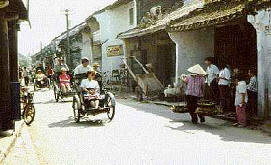The Origin of the Tăng's family
In Minh-Hương village, Hội-An city, Quảng-nam province, Việt-Nam
The Tangs who were of the Hán branch, had their roots in the Chinese village of Đồng An, District Tuyền Châu, province Phúc Kiến, China.
Around mid 17th century, the third patriarch Tăng Xích Nương left China for Việtnam, and originally took refuge at hamlet Tu Lễ, village Cẩm Phô (now Cẩm Hà), district Điện Bàn, province Quảng Nam. Later on he moved into the village of Minh Hương, Hội An city of the same province, especially established by order of Lord Nguyễn-phúc-Chu in 1698 to accommodate the refugees who left China because they did not want to submit themselves to the Qing Kingdom new rulers.
In Hội An, the Tangs have a family temple that was built more than 300 years ago. Coming from Đà Nẵng city, it is located on the left side, at # 38 Duy Tân street. Lai Viễn Kiều, mostly known as Chùa Cầu, is about 300 meters down the street. The fairly good size family temple has a second story in the back, with thick walls built with clay and honey, because cement was not yet available at that time.
Entering the temple, your attention is caught by a big lacquered golden laced wood panel with three golden characters ‘Tăng Từ Đường’ (Tăng’s family temple). Hanging around there are four more well decorated panels offered as gifts by government officials or influential personalities of that time. One of them, presented by then District chief Ngô Đ́nh Diệm, who later became President of the Republic of Việtnam from 1955 to 1963, was of rare wood with four golden words ‘Nam Hải Tân Triều’.
The meanings of the four panels preserved at the temple are as follows:
‘Bàn Bạc Vạn Lư’: The Tangs are soaring over thousands of miles.
‘Tinh Tụ Từ Đường’: Many distinguished Tăng come from here.
‘Nghệ Quốc Văn Chương’: Well known artists and writers.
“Nam Hải Tân Triều’: A new wave has reached South China sea.
The Tăng’s family temple is classified by local authorities as one of many protected structures of the Hội An ancient city, which is recognized by the United Nations as part of the world protected cultural legacy in 1999.
The city has attracted thousands of foreign visitors and archeologists every year.

The Hội-an ancient city has attracted thousands of foreign visitors every year.